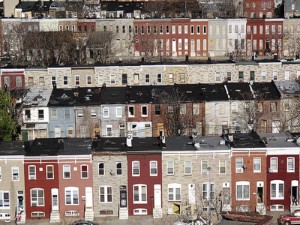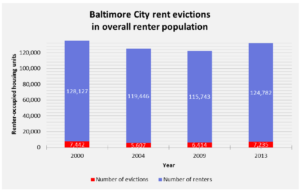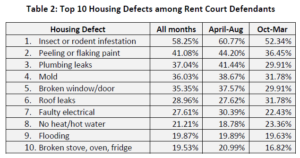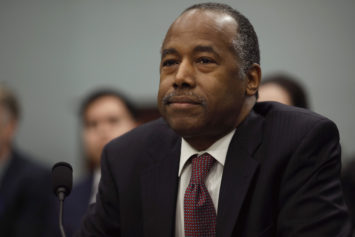
The new report—Justice Diverted: How Renters Are Processed in the Baltimore City Rent Court—has made some disturbing findings concerning the practice in the city, where 7,000 families are evicted each year. Baltimore ranks second in the country, second only to Detroit, in the percentage of people who face the threat of eviction. Further, 60 percent of renters had valid legal reasons to challenge their eviction, the study found, but lost their home because they lacked the resources to hire a lawyer, and they did not understand their rights.
“Our study shows that the court system prioritizes efficiencies which privilege the landlord’s bottom line, and as a result, it decidedly ignores two predominating realities of poor renters and their housing,” the study says. Of the 278,809 filings in Baltimore City rent court, more than half are landlord-tenant cases, nearly all of which are brought by landlords.
To begin with, renters flounder in an unequal system in which the game is rigged. Half of renters surveyed knew almost nothing on how to defend their cases. Further, they usually face the court system alone, while landlords typically have a lawyer or a debt management agent.
“Then, institutionalized customs of the court steer renters away from defending themselves, instead pushing them into agreements that have no effect on the considerable problems renters face at home – namely, overspending on insecure, unsafe, unhealthy housing,” according to the report.
Sadly, 75 percent of renters are unaware that toxic mold and other serious defects provide legal grounds for fighting an eviction.
In addition, renters are low income, as rent court defendants are among the most vulnerable residents of the city, with few options other than Baltimore’s crumbling housing options. As a result, these residents are often pushed into substandard housing, or with leases they cannot afford.
“Renters are strapped for real housing options. Most can barely afford to pay $700 in monthly rent, yet the prevailing fair market rent… runs over $1,200 for a two-bedroom unit,” the study says.
Of the two groups surveyed, 56.9 percent of residents in the first group were on public assistance, as were 38.5 percent of people in the second group. The report found that 94 percent of the defendants are African American and 79 percent are women, and three-quarters survive on $2,000 or less per month. Further, 80 percent had serious housing defects when they went to court, and more than 70 percent told their landlord about the problem.
Making matters even worse, according to the authors of the report, half of landlords submitted invalid licensing and registration credentials to the court in order to get on the docket. Further, 80 percent of the landlords gave false, outdated or unsubstantiated information regarding mandatory lead risk reduction compliance.
“The data in this report illustrate that this broken system puts long-standing tenant protections and basic housing standards second to landlords’ bottom line,” according to the report, identifying Baltimore Rent Court is a culprit.
Meanwhile, a house-to-homeless pipeline flourishes, as city leaders have displayed little concern over the Baltimore eviction crisis and the ripple effect it has on families and communities, and a host of issues including health, education and employment.
The report makes a set of recommendations, including:
- Cutting rent court dockets in half and change the process by giving renters more time to remedy the dispute and prepare for court;
- Leveling the playing field by increasing legal assistance for renters and therefore slashing the number of evictions. A Massachusetts study found that two-thirds of tenants with legal aid services avoided evictions and kept their homes, while two-thirds of those without legal aid were thrown out into the streets;
- Holding landlords accountable by demanding that they document their rent claims and compliance with licensing and lead-risk legal requirements;
- Expanding landlord licensing requirements, including health and safety inspections for all rental housing, not only multi-family dwellings and rooming houses;
- Funding eviction prevention programs to address the extent of the crisis.
The death of Freddie Gray in police custody, and the protests and civil unrest that followed, provided a window into the underlying economic exploitation and social segregation of poor Black Baltimore. Police brutality is one of the more conspicuous symptoms of a system of violence against Black people. Recent studies have shown that big banks and hedge funds exploit Baltimore’s Black poor by buying up liens on homes related to unpaid water bills. These billionaires hike up the interest, and auction off the homes because these Black families are unable to pay.
In addition, banks are shutting out mortgage opportunities to Blacks, denying loans solely on the basis of race rather than other factors such as income. Although Blacks outnumber whites 2-to-1 in Baltimore, banks gave mortgages to twice as many whites as Blacks. In addition, when poor Black residents face police brutality and the killing of a loved one at the hands of police, often they are forced to sign a nondisparagement clause, amounting to hush money the city will take back if these victims fail to keep quiet about what happened to them.





